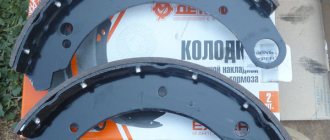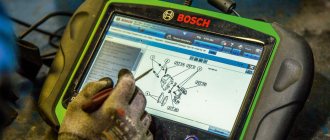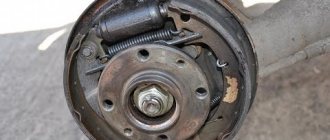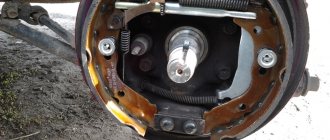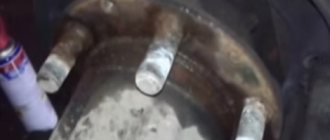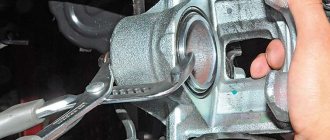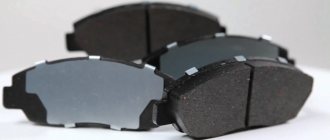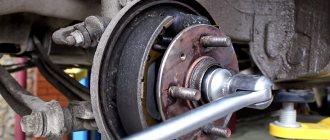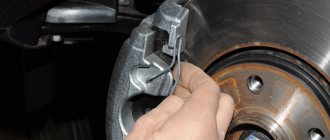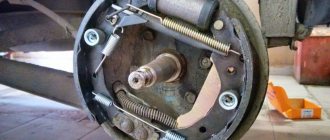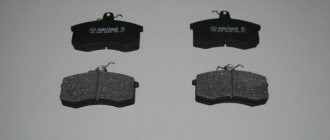How to unlock the pads
There are many ways to unblock frozen pads, most of them rely on heating the brake mechanism. This usually requires removing the wheel. If you have drum brakes, you will hear a metallic click when the pads defrost. This means that the spring has snapped out and the pads are in place.
So, you need to remove the wheel and do one of the following:
- pour hot water over the brake mechanism. Hot water can be boiled in a kettle or poured from a tap and brought in a bucket or, for example, a 1.5 liter bottle
- Place the hose on the exhaust pipe and direct it to the brake mechanism. A good way to defrost the pads is if you have a hose of suitable diameter on hand. For example, a hose from a vacuum cleaner or something else might be suitable. Hot smoke coming out of the exhaust pipe under pressure will help
- tap the drums with a hammer, but not too hard, otherwise you can split them - if there is no way to heat them
- heat the drums with fire from burning paper or a blowtorch. The simplest blowtorch costs about 400 rubles, but in winter it can save you in many cases. Just be careful not to overheat the brake drums and that the fire does not reach other parts of the body, otherwise you may damage the paint or start a fire.
- pee on the drums. If it is impossible to use other methods and moral principles allow, then being somewhere on the highway or in a field, you can use this method, you just need a good supply
If you decide that you can unlock the pads by simply setting off and driving a few meters, after such a trip you will probably have to change these pads. This is because the linings on the pads can be torn off. It also happens that the handbrake cable freezes, so if it doesn’t work with the pads, try heating this cable, which goes to the rear wheels along the bottom of the car. Just be very careful when using fire.
Method 1. Heating the pads using improvised means.
Let's consider the available options with which you can defrost the pads:
Hot water.
The only thing you always need to be aware of is that hot water is very likely to crack the pads in very sub-zero weather. If the temperature difference is not that strong, then this simple and cheap method may work. You need to pour very warm water, but not boiling water, over the center of the wheel rim or brake drum.
Evidence that the method worked will be a characteristic click of the pads moving away from the drum. After this, you should not leave the car idle for a long time, because in the cold the water on the wheels will turn into ice again and the pads will freeze much more strongly to the brake drum. You will have to defrost the brake drum using the same method a second time, and it is not a fact that it will work this time.
Hair dryer.
This method is most often chosen by the fair half of humanity. Although men also use this method using a special hair dryer. Blowing the drum with a hairdryer is considered the safest way, because even in severe frost, the pads do not crack, since the ice from blowing with a hairdryer melts smoothly, and therefore slowly, which is not suitable for people who are in a hurry on business. In addition, you need to stretch an extension cord from the outlet to the car to connect a hair dryer, which is also not a convenient action. In this case, a hairdryer that can be connected to the cigarette lighter in the car is ideal.
Exhaust pipe.
To defrost the pads with warm gas from the exhaust pipe, you will need a flexible pipe, for example, a hose from an old vacuum cleaner, with a diameter that matches the diameter of the pipe from the car. Insert one end of the flexible pipe into the exhaust pipe, bring the other end to the frozen wheels and start the car. After some time, the exhaust gases will melt the ice, returning the brake pads to their normal position. If the hose is very short and does not reach from the exhaust pipe to the wheel, then in this case you can stop any passing car, where the driver will agree to help you.
In this case, the second car stops closer to the first, so that the distance from its exhaust pipe with the help of a hose reaches the wheel of the first car blocked by ice. It is strictly not recommended to use this method indoors to avoid carbon monoxide poisoning.
Blowtorch.
This is the most dangerous method of all of the above. It can cause a fire; to prevent this from happening, you need to keep the lamp at a distance of 1 meter from the brake drums. If possible, do not resort to this method.
But what to do if you find yourself far from civilization, where you can’t get hot water, you can’t connect a hairdryer, and you don’t have a blowtorch or hose lying around in your trunk? In this case, the second method will help you out.
What to do if the handbrake on disc brakes is frozen
In cars with disc brakes on the rear wheels, when the handbrake pads freeze, it is somewhat easier to free them from the ice. Since there is open access directly to the brake pads themselves, you do not need to remove the wheels to defrost them.
If the pads to the brake discs are frozen, you can free them using improvised means that are available in the trunk of almost every motorist in winter (for example, an anti-freeze bag or an empty plastic bottle). We offer your choice of three simple ways of what to do if the parking brake pads are frozen.
Method 1: Defrost the pads with anti-freeze
Perhaps this is the most obvious way to get out of a situation where the handbrake pads are frozen to the car’s brake discs. After all, most drivers have non-freezing liquid in the trunk.
To defrost the brake pads, you first need to slightly open the lid on the flask with liquid (so as not to waste a lot of it) and pour anti-freeze onto the brake mechanism on the locked wheel through the holes in the wheel rim. After this, literally in a couple of minutes, the ice will melt and you will be able to drive.
When starting to move, be sure to press the brakes five to six times to remove the oil film from the surface of the pads.
Method 2: Defrost the pads with saline solution
This method can be a great help for fishermen in winter if, for example, the handbrake suddenly freezes while fishing. After all, in the trunk of a self-respecting fisherman, there will probably be a flask of water and a pack of salt.
You need to prepare a saturated salt solution right in the flask, which can effectively melt the ice on the brake pads, and at the same time prevent the melted water from immediately freezing. You can water the pads with the solution, as in the previous anti-freeze method, but you don’t have to save water.
Keep in mind that the water should not be very hot, otherwise you will ruin the brakes!
Method 3: Melt the snow and defrost the pads
If the handbrake pads are frozen in your car, and there is nothing in the trunk except an empty plastic bottle, then, if there is snow, all is not lost!
To do this, you need to collect more snow in the bottle, then place it in the car interior as close as possible to the heater air duct, and turn on the heater to maximum. The snow will melt and turn into water, after which it can be poured onto the pads.
We recommend: Rating of the best oils for high mileage engines in 2021
After defrosting the brake pads, you must drive immediately, otherwise the water will freeze again.
As we wrote above, to prevent the handbrake pads from freezing, never put the car on the parking brake in cold weather. And when leaving the car in the parking lot for a long time, park it so that when leaving, the first movement is in reverse - it is easier for the entire mass of the car to unlock the rear brakes.
Reasons for freezing
Some motorists are not at all sure whether the handbrake can freeze in practice and why this even happens. In fact, you shouldn’t be surprised by this fact. Freezing is typical for any car, regardless of the make, model or year of manufacture.
Here it is more important to understand why exactly the handbrake on a car freezes, as well as how to deal with it. The situation is quite paradoxical, since automakers have always strived to provide the most effective ventilation for the brake discs and drums on the car. Thorough airflow helps cooling. But when frost hits and humidity rises, settling moisture begins to accumulate and form an ice crust on surfaces.
At the same time, moisture accumulates in hidden cavities that are located at a certain distance from the ventilated space. This also includes the hand brake assembly. Water accumulates especially actively when it acquires various states of aggregation, turning from liquid to vapor, and then becoming liquid again.
Moisture will accumulate gradually, filling the space and causing the handbrake to freeze. After washing in winter, it is recommended to blow out the brake system and handbrake assembly using hot air. But not everyone does this. The settled moisture turns into an ice crust, and when the handbrake is turned on, within a few hours it can stick tightly to the brake elements of the wheels.
Wheels can become blocked for several main reasons:
- the brake pad freezes to the surface of the drum or brake disc, depending on the design of the car;
- the brake cable freezes on the side of the outer shell when the handbrake is turned on;
- jamming occurs that is not associated with freezing.
Here it is important to distinguish freezing from jamming. The latter happens in any weather, that is, it can happen in summer and winter. But freezing is typical exclusively for the winter period, when there is sub-zero temperature outside with high humidity.
To accurately determine the malfunction, you need to dismantle the wheels, remove brake pads and drums or discs, inspect the area, etc. But usually there is no time for such manipulations. In some conditions, the problem must be solved in a maximum of an hour.
In reality, everything happens quite simply in the daily life of a motorist. He drives through puddles or visits a car wash. Arriving home and turning on the handbrake, the moisture crystallizes, turning into a dense ice crust. She does not allow the handbrake to be released because it is frozen. Moreover, huge volumes of moisture are not required here.
Frozen car handbrake cable
It is impossible to say exactly at what temperature the handbrake gradually freezes. The process definitely begins to develop when the temperature drops below 0 degrees Celsius. But often we are talking about more serious frosts, from about 5-10 degrees below zero or less. Then the frozen device does not come off by simply lowering the brake, if the car is equipped with a classic handbrake with a mechanical drive. The situation with the electronic handbrake is even more complicated.
But if everything is quite clear with the brake pads, since they are located outside, then the issue of freezing of the handbrake cable causes confusion among many. When the machine comes into contact with water and moisture, copious amounts of fumes are generated. Especially after starting to move, when the car heats up, the water evaporates and turns into steam. But when it stops, the condensation process resumes and the steam becomes water again.
As it cools, condensation affects components with high thermal conductivities. The end of the handbrake cable is located outside the car body, and therefore it is the one that begins to cool first. This is where the process leading to the formation of ice begins.
The end of the handbrake cable gradually attracts moisture towards itself, and it already ends up in the cable channel. In this far from cunning way, he freezes.
Next, you need to understand what needs to be done by a driver who has put his car on the handbrake, and the brake pads suddenly froze. Be sure to put yourself in a similar position, since this situation is possible for everyone. It is better to be prepared in advance and have several effective means to eliminate the problem of freezing handbrake.
Unlocking the brake system
The standard reaction to the brakes locking in the cold is the desire to remove the ice by moving the car away sharply and powerfully. The attempt will probably be successful and the freezing area will be unlocked. However, the clutch disc may break or the linings on the brake pads may come off. Remember that repeated attempts to move while the wheels are locked can burn out the clutch.
You can try to unlock the wheels using the engine, but you do not need to use full power. Try to just start moving. If it doesn’t work on the first try, slightly increase the engine speed and try to move again. If it doesn’t work again, you need to use other methods.
Take a hammer, wrench or metal pin. Using gentle movements, tap the brake disc through the wheel holes. Walk around the entire perimeter of the disk. The ice should crack due to vibration. This is the simplest method.
If these methods do not help, use other methods to warm up the brake pads:
- Hot water. Pouring water from a kettle onto a wheel disk is not an effective heating method. To reduce the number of trips for water, use a watering can and a hose attached to its neck. The hose must be pushed through the disc spokes directly to the drum or brake caliper, into the area where the pads are located. Do not forget that after the brake components have thawed, you must start driving to dry the brakes.
- Construction hairdryer. Using a conventional hair dryer in winter is ineffective, so you need to use a hair dryer. If the wheel spokes are located at a sufficient distance from each other, the brake drum can be unlocked even without removing the wheel.
- Exhaust gases. To warm up, you will need a hose that is sized to be inserted into the exhaust pipe or installed on the pipe. The second part of the hose must be inserted between the spokes of the wheel disc and directed directly to the brake drum. The method does not require additional effort, but if the hose does not fit tightly to the exhaust pipe, heat loss will occur. To reduce the warm-up time, increase the engine speed, but this will increase fuel consumption.
- Blowtorch. When heating the brakes with an open fire, make sure that the brake hose and ABS sensor wire do not burn out.
- Antifreeze. Products for cleaning glass surfaces, defrosting locks, coolers - they all include components with a low freezing point. The contact of the antifreeze with ice leads to the fact that the ice begins to melt. The main thing is to use liquids that do not contain silicone components. Pour anti-freeze liquid onto the pads and wait until it takes effect. Such means will not be able to completely melt the ice, but it is easy to loosen its “grip”. This is enough to break the ice when you start moving.
What to do in case of frozen brake pads?
If a new would-be driver doesn’t know what to do if the pads are frozen, you can resort to the advice and experience of experienced car enthusiasts who have repeatedly managed to successfully solve the problem. Naturally, it will be better if the car owner takes care of his iron assistant in a timely manner and prevents this kind of trouble, but if this still happens and the brake pads are frozen, you should resort to some auxiliary means.
So, what to do if the pads are frozen:
- First of all, you should try to move off smoothly and as carefully as possible. There is a possibility, if the frozen pads have not frozen too hard, to tear them off the brake disc.
- You can use hot, but not boiling water. You can bring it to your car in absolutely any container from home, but if the car is parked, you can ask the security guard for help. If the brake pad can be defrosted, a characteristic cracking sound will be heard from the brake disc. If you use this method, you will need to “dry” the brakes when you start driving.
- If there is an outlet and an extension cord in the immediate vicinity, you can resort to using an ordinary hair dryer designed for drying hair. Having an electric convector, you can also try to warm up a frozen braking device.
- Among other things, warm air can be delivered to the brake mechanism through a hose of a certain length, which can be put on the exhaust pipe.
How to properly unblock frozen brake pads
The first step is to determine exactly which wheels are frozen. To do this, it is enough to start very smoothly and slowly drive 40-70 cm. Under the wheels whose pads are frozen, a snow threshold forms under the tread.
The second step is to take a hammer or a more or less weighty object, a wrench or a suitable metal pin, and carefully, lightly tap the brake disc through the holes in the wheel. Slowly, tapping with a knob and hammer, we will walk around the perimeter of the disk several times.
- hit the wheel rim or wheel nuts;
- try to break frozen pads by hitting the brake calipers;
- try to turn the wheel with a pry bar, using the mounting studs as a fulcrum.
What to do if the rear brake pads are frozen: the operating technique is the same, but you need to be careful with dosing the force. Cases where drum brake pads are frozen occur much more often due to the specific design of the drum. If there is significant wear on the working surface of the drum, ideal conditions are created in the resulting annular groove for the accumulation of condensate and melt water.
Advice! In the cold, it is difficult to dose the force due to reduced sensitivity of the fingers, but the force of the blows must be consciously limited; a cast iron drum can easily split, especially if there is already a crack, chip or deep gouge.
For the same reason, when you regularly put the handbrake on the car in cold weather, it happens that the handbrake brake pads freeze. What to do? In cold weather, lock the car only using reverse gear. If the handbrake is stuck, when you turn it off, you will not feel the characteristic, subtle push - the reaction of the brake spring to the release of the load. In addition to the brake pads, the handbrake may freeze the drive cable in the metal sheath. The cause, as a rule, is condensation and moisture accumulated in the cable tunnel.
To unlock the handbrake cable, you need to gain access to its attachment point on the rear brake pads:
After defrosting and drying the handbrake in a warm box, be sure to treat the cable with lubricant, following the recommendations in the machine’s operating manual.
Recommended: 15 Best H11 Bulbs
An ingenious way to defrost wheels with frozen pads is to use car exhaust gases. Their temperature at the exit of the exhaust pipe will be at least 100-120 degrees. If you have a hose at hand with a diameter that matches the size of the exhaust pipe, feel free to put on and warm the frozen pads. This method can be recommended as a universal one for those drivers whose brake pads constantly freeze. You just need to choose a hose that is suitable in size, length and material.
Please note! Despite the abundance of advice from various experts who know better than anyone what to do if the brake pads are frozen, pay attention to their video - almost no one uses hot water.
Hot water is an effective way to defrost the pads, but it requires considerable effort and great care. To obtain the required effect, you will need at least 3 liters of boiling water per drum; you must first remove the wheel and pour water very carefully, avoiding liquid flowing into the brake mechanism. Otherwise, you may get the opposite effect.
Wheels don't spin: fighting freezing brake pads
No matter how much you prepare for winter, the first frosts still come unexpectedly. And so in the morning you get into the car, start the engine, but you can’t get going... Frozen brake pads are a fairly common problem for car enthusiasts during frosts. Is it possible to avoid this trouble, and how to “unfreeze” the pads if the cold has already taken its toll?
First, let's figure out why brake pads can lose mobility and make it difficult for the wheels to spin. There are three main reasons.
The first is related to a breakdown in the brake system. The wheel may simply jam due to faulty brake pads or discs
. Sometimes the brake cylinder fails. This can also lead to wheel stalling. You can tell that the brake mechanism on a car has failed by the feeling of a heavy load attached to the car. In this case, the driver will need the help of a tow truck, which will throw the car, which does not want to continue driving, into the warm bay of a car repair shop, where specialists will be able to identify and fix the problem.
The second reason sounds funny, but this also happens in the lives of some drivers. Car wheels can freeze to the asphalt
, if you leave the vehicle in a puddle of water, which will be frozen by the night cold. As a result, the rubber tread of the wheel seems to grow into the ice crust. However, eliminating the problem is not difficult. It is enough to chip the ice around the tire or even just rock the car.
Now let's move on to the third, more popular reason why the brake pads could freeze to the discs. Obviously, the brake mechanism in a car cannot freeze by itself. Ordinary water helps it freeze. Perhaps the driver stopped at a car wash the day before, or maybe he rolled through deep puddles or got his wheels stuck in slush and then didn’t dry them enough. Frost hit at night and... voila: the wheels refuse to spin. Moreover, both the front and rear pads can freeze.
And it also happens that the motorist did not go to the car wash.
and didn’t plow through
puddles
, but the wheels still refuse to spin.
Again, the culprit is water, which forms in the form of condensation
on the surface of the brake pads and discs. During braking, the brake discs begin to get very hot. After stopping movement, steam settles on the elements of the brake mechanism, which freezes in severe frosts. And if the distance between the brake discs and pads is adjusted incorrectly, then condensation can easily bind the wheel tightly.
Despite the prevalence of the problem, not all motorists know what to do if the brakes are seized by frost. Intuitively, drivers try to break off the ice crust by sharply and powerfully accelerating the engine. Sometimes the attempt is successful, and the wheel begins to turn, but it is not a fact that this will not result in a trip to the car service center, since the clutch disc or lining on the brake pad has broken. What is the right thing to do in this situation without causing further damage to the car? Should I call a tow truck or try to “warm up” the wheels by resorting to old proven methods? If you chose the second option, then our article will help you with this!
Unblocking frozen brake pads
First of all, try to drive a little smoothly, barely pressing the accelerator pedal. If the brake mechanism has frozen a little, then the ice can be “broken off” without causing damage to the car. In any case, even after driving a distance of about half a meter, you will be able to determine from the mark left on the road which of the wheels were caught in the frost.
But what to do if the brakes are frozen solid? There is definitely no point in arranging a competition between the engine and the brake mechanism: as we noted above, the latter can easily fail. And the gearbox runs the risk of overheating, especially if the car is equipped with an automatic transmission.
So, method one.
Water against water.
It is clear that we are talking about its different states. Warm water
will help melt hard ice . She needs to water the brake pads. However, it is important that it is not boiling water, otherwise you will do more harm than good.
When you hear a specific cracking sound of ice, it means that the process has begun. After such “defrosting”, you need to immediately set off and dry the brakes while driving by intensively pressing the corresponding pedal several times. Let us immediately note that this method is good if it is not very cold outside. If the temperature drops below -10 degrees, the warm water will instantly cool down before the driver has time to move, and the wheels will lock even more firmly.
As a second mate
A hair dryer
can help defrost the brakes . A hair dryer will not work here, but a more powerful construction option will be just right! However, it is necessary to use the device with caution, because under the influence of hot air the paint on the wheel rims may peel off. Of the obvious advantages of this method: you won’t need to dry the brakes after using a hair dryer, because it will not only defeat the ice, but also evaporate excess liquid.
Some motorists prefer to warm their brake pads... with exhaust gases
, because they heat up to 100 degrees and above.
If you want to use this extraordinary third method
, take a hose and put one end of it on the exhaust pipe, and point the other towards the wheels.
Fourth method
consists of using
lock defrosting agents or alcohol
. You can pour them over the frozen mechanism and wait a while until the ice begins to melt.
And finally - the fifth method
.
You can take a hammer and gently tap the brake disc through a wooden strip
. This method will help break the ice and free the wheel. However, you need to be careful and measure your efforts.
To never encounter frozen brakes...
... you need to follow a number of simple rules.
First, never leave your car with the handbrake on in winter. In the cold season, it is preferable to use gear. It is better to park vehicles with a manual transmission in first or reverse gear, and cars equipped with an automatic transmission in the “Parking” mode. The handbrake should only be used when you leave the car on a steep slope.
Secondly, before parking, you need to dry the brakes by pressing the brake pedal vigorously several times. Then the brake pads and discs will become hot, and the moisture present on them will evaporate.
If this is possible, then it is better to avoid puddles on the roadway, and if this fails, then be sure to dry the brake mechanism.
In addition, even before the start of the frost season, the motorist needs to adjust the gaps between the brake pads and discs so that moisture that suddenly gets between them does not freeze the mechanism with ice.
We hope that our advice will be useful to all drivers. And you can avoid such an unpleasant situation early in the morning. Well, if suddenly a “surprise” crept up unnoticed, then now you know exactly what needs to be done.
What to do?
First of all, you should make sure that the problem lies specifically in the handbrake, since it may not move for other reasons. Next, you should raise and lower the lever several times; if the manipulations do not lead to anything, then you need to move on to the next steps. You can try using boiling water, which should be poured into a kettle. Pour liquid over the brake drums, and after the wheels start moving, be sure to dry them using sharp braking using the handbrake.
This is the fastest way to get rid of the existing problem. If this idea does not cause delight, then it is necessary to supply gases emitted by the machine to the frozen brakes. For this purpose, a hose is used, one end is attached to the gas exhaust pipe, and the other is directed to the frozen part.
This will require a lot of time, and you will also have to be patient. There are also easier methods:
- Use a heat gun or hair dryer; a gas burner will also work. Direct hot air onto the icy part and wait until it defrosts completely.
- If there are no available means nearby, then you can use a regular block of wood and tap it on the brake drums. Sometimes this helps get rid of the ice crust.
- It would be quite reasonable to use special liquids that are suitable for defrosting locks. But to do this, you will need to lift the car with a jack and remove the wheels, since it is not such an easy task to get to the brake drums.
Attention! You shouldn't just hammer on the wheels. It's a waste of time. You should also not use open fire, such as homemade torches or a blowtorch.
Blowing with a hairdryer
This method is one of the least dangerous. Warming up occurs smoothly, which eliminates the risk of cracking of the drums. This is also where the inconvenience comes from. The defrosting procedure with a hairdryer takes a lot of time. In addition, the operation of an electrical appliance requires an extension cord that can reach the vehicle from the nearest outlet.
Instead of a hairdryer, you can use a blowtorch - a high-temperature gasoline burner. Its use is associated with the risk of fire, as well as the risk of overheating of the brake mechanisms. Therefore, it is better to warm up from a distance of 0.5-1 meters (depending on the intensity of the flame).
How to avoid pads freezing?
To protect yourself from such cases, you can follow a number of simple rules:
- Before parking the car, dry the brakes well and drive, braking with both the regular brake and the handbrake. Just don’t pull the handbrake all the way, a slight lift is enough, otherwise you can damage the cable
- Do not use the handbrake in winter. Bet only on speed. And when autostarting, raise the handbrake to the minimum height, only so that the handbrake sensor is triggered
- Before winter, clean the drums from dirt, unless of course you have drum brakes
Following these simple recommendations will help you avoid many problems with your pads. If none of the methods suits you or is not applicable in your situation, come up with your own. The main thing is that the pads or cable heat up and move into place. If you have an unusual or very convenient way, write it in the comments, because sharing your experience is always useful.
Preventing brake freezing. How to prevent pads from freezing?
The best way to solve a problem is to prevent it. To do this, you need to adhere to the following tips:
- Dry the brakes before parking . To do this, you need to brake intensively several times or drive a little, slightly tightening the handbrake. The pads and drums will heat up and the moisture will evaporate.
- Do not tighten the handbrake while parking . On level ground, the car is securely held due to the engaged first speed or the “parking” mode on the automatic transmission. In this case, the risk of the pads freezing is reduced and the possibility of the parking brake cable freezing is completely eliminated.
- Adjust the gaps between the disc and pads . Parts freeze more often when the distance between them is small.
- Avoid puddles . Moisture gets onto the pads and into the handbrake cable only when driving into a snow slush or puddle. Try to prevent this from happening before parking the car.
The best way to deal with frozen pads in a garage or in a parking lot near an outlet is to use a hair dryer or a heat gun. But in frosty weather, the brakes can “catch” in the parking lot of an office or supermarket. Therefore, always take a freezer with you, do not put the car on the handbrake unless necessary, and do not forget to dry the brakes before parking.
The pads are frozen to the drum - what to do?
Defrosting brake pads if they are frozen to the drum is somewhat more difficult than on cars with disc brakes on the rear wheels. The difficulty is that the pads are located inside the brake drum, and there is no direct access to them.
In such cases, there are two ways to unlock frozen rear pads: by heating or by mechanical force. The first method is simpler and less labor-intensive, and the second is more reliable.
Method 1: Heat the pads frozen to the drum
The advantage of this method is that in most cases you will not need to jack up the car and remove the wheels to defrost the brake pads. The downside is that if the brake drum is difficult to reach, then this method is unlikely to suit you.
It is not the pads that need to be heated directly, since they are located inside the brake drum, but the drum body. To heat it, you can go in two ways:
- If you are close to home, you can heat the brake drum using hot water, pouring it from a bottle or kettle. But you need to remember that in severe frost the water cools quickly and can freeze the pads to the drum even more strongly.
- If you have a suitable piece of hose in your trunk (for example, a hose from a vacuum cleaner), you can attach one end of it to the exhaust pipe, and direct the other end to the brake drum. Over time, the car's exhaust gases will defrost the pads and free the wheel from its icy shackles.
But what to do if the rear brake pads are frozen far from home, and you have neither hot water nor a hose, and in the trunk there is only a jack, a wheel wrench and a simple set of tools? Then the second method will probably suit you.
We recommend: Changing the VAZ 2110 crankshaft oil seal yourself
Method 2: Tap the drum and release the pads
If the handbrake is frozen on a car with drum brakes, then the surest and most reliable way to unlock the rear wheels is to remove the wheels and, by tapping on the perimeter of the drum, free the pads from the ice. To do this, you need to do the following with each of the locked wheels:
- Put the car in gear;
- Loosen the wheel nuts with a wheel wrench;
- Raise the car with a jack and remove the wheel;
- To break the ice, you need to tap the brake drum with a hammer.
To avoid damaging the brake drum, you should not knock on it directly, but through a wooden spacer (for example, through a piece of board).
- If you don’t have a board, you can use a wheel wrench - place it on the drum and lightly hit it with a hammer, as in the video at the bottom of the page;
- Tap the drum in a circle until you hear a characteristic crackle of ice;
- When the pads are free of ice and the drum can rotate freely, screw the wheel into place and move on to the next one;
- Having thus freed all the frozen pads from the ice, try to move off smoothly.
To avoid getting into similar situations in the future after driving in slush, before parking while driving, press the brake pedal several times to dry the pads. And it’s better not to put the car on the handbrake at all in cold weather, leave it only in gear.
Defrosting methods
If you live in a region with fairly harsh and cold winters, at least one of the products presented below must be present in your car when the weather gets colder.
No one can predict whether your brake pads will freeze or not. The behavior of the handbrake is sometimes unpredictable. For some people, even in deep minus conditions outside, everything works fine. For another motorist, even at -4 degrees Celsius, the brake may jam due to accumulated moisture, and it becomes impossible to move without damaging the brake assembly.
There are several effective remedies for those who do not know what to do if the handbrake is frozen. You can cope with this situation with the help of:
- defrost;
- alcohol-containing substances;
- hot water;
- construction hair dryer.
It is better to put aside the option of using open fire. It is used only in the most emergency situations, when it is not possible to use safer means.
Using defrosters
This is a special tool that helps in solving emergency problems related specifically to the freezing of various mechanisms, locks, etc. They were created not only for use on cars. Defrosters are perfect for those who need to open a barn lock, use a key to get into the cylinder of the locking mechanism, and remove ice that has formed from various devices and mechanisms.
Each manufacturer has its own special composition, which is not always available in the public domain. In fact, it is a solution offered primarily as an aerosol spray. It contains components that help defrost ice. Moreover, the drug can reach quite hard-to-reach places.
If you often operate your car in winter and regularly use the handbrake in sub-zero temperatures, the likelihood of it freezing is quite high. Therefore, it definitely wouldn’t hurt to get a can of defroster for this period. It takes up minimal space in the trunk, but can help out in a difficult situation.
If you have a defroster, you will know exactly what to do if the handbrake pads are frozen to the brake discs or drums on your vehicle.
Using fluid to defrost handbrake pads
Liquids containing alcohol
As previously noted, the handbrake freezes equally often on both disc and drum brakes. The type of brake unit does not play a key role in this matter.
If you don’t have a defrost at hand, there is an alternative option to cope with the problem. A substance that contains alcohol and does not freeze at subzero temperatures, as happens with ordinary water, will help you.
These liquids include fuel, regular technical or medical alcohol, and window cleaners. They contain alcohols, which allows them to cope with ice quite effectively.
Surely at least something from the presented list is in your car. Almost every motorist carries with him a container for washing windows and glass, since such a liquid can be useful on the road. There are also ways to drain small amounts of fuel. There are doubts about pure alcohol, but if you are near a pharmacy, the problem is also easily solved.
The essence of using such liquids is extremely simple. They need to be applied to the pads and wait a while. Do not forget that alcohol is highly flammable. Therefore, you should not illuminate your brake assembly when applying alcohol-containing liquid with some open flame source. Otherwise, accidental fire may occur.
At the same time, alcohol-containing liquids are highly effective. They dissolve the ice, which allows you to remove the car from the handbrake and go about your business. These products do not cause any harm to pads, discs and drums.
Water
Since not only the pads of a car parking handbrake can freeze, but also the handbrake cable, which is not so easy to reach, it is important to understand what to do in such a situation and what means can help if the components are frozen.
Some will be surprised, but you can use ordinary water. This is another example of a fairly effective means that allows you to freeze the parking brake pad, as well as treat the frozen cable of a problematic handbrake. The advantage is that you don’t have to save water.
Only an important amendment should be made immediately. In extreme cold, you should never use boiling water. This will be detrimental to the car, paintwork, metal, etc. It is too dangerous to use boiling water at a temperature of about 100 degrees Celsius. But there will be no damage from just hot water. Therefore, water is considered one of the safest and least aggressive methods of combating freezing of the handbrake pad and cable.
It is unlikely that anyone will have difficulty pouring hot water over frozen parts. But here it is important not to wait until the opposite effect occurs and the brakes begin to become covered with an icy crust again. This is exactly what will happen if you remain in place after the nodes have thawed. It is important to move off immediately in order to develop the knot and prevent ice from appearing again.
There is one more important point. After the ice is removed, water still remains on the surfaces. You should get rid of it. This is done extremely simply. Once you hit the road, operate the brake pedal. You need to brake carefully for the brake mechanism to work. When braking, a heating process begins due to friction. When heated, the water will gradually evaporate.
Steam heating
Hairdryer
There is a good option for what a motorist should do when the handbrake cable on his car is frozen or the brake pad is frozen. Since the optimal solution is to use air at a higher temperature than the ambient temperature, it would be correct to use a hairdryer.
Moreover, a hair dryer of construction and household type is suitable, but with sufficient power. It is important that the heated air flow reaches the treated area.
In theory, the option of using a hair dryer looks the most attractive and suitable for such situations. But in practice everything is somewhat different.
First, the driver will need to find the hair dryer itself. And this is not easy to do if it is outside the house or garage. The next obstacle is the lack of a nearby power source. Such units cannot be connected to a car electrical network. A voltage of 220V is required here. And he definitely won’t be somewhere in the middle of the field.
But if the handbrake on your car freezes near the house or while parking in the garage, where finding an outlet and connecting power with an extension cord will not be a big problem, then you should consider the option of using a household or construction hair dryer.
Be careful when choosing the temperature setting. Excessive overheating is not necessary. You can simply supply warm air under high pressure. This is better than turning on a lower fan speed, but at maximum temperature.
Each motorist decides for himself which method to use. This largely depends on the specific situation in which he finds himself, and which of the presented means can be used. Some people will have no problem finding a hairdryer and connecting to a 220V household outlet, others will find it easier to use heated water, and still others will have a special defroster at hand.
Reasons why brake pads freeze
At low temperatures, the liquid becomes ice, and if it has accumulated between the pads and the brake disc, then when it freezes, the pad and disc will lock together and become blocked. A similar effect occurs with the onset of severe cold weather after driving a car in warm weather, when water appears on the contacting surfaces when large puddles pass. Freezing of the fluid causes the brake pads to bind.
However, the main reason for freezing is using the handbrake in cold weather. If a motorist has not dried the brakes well enough and then put the car on the handbrake, the liquid that remains on the surface of the pads and discs will become ice and tightly connect them. The chance that the pads, while in the unclamped position, will freeze to the disc is high only if the recently installed pads are brought too close to the drum.
It also happens that the driver has not been to the car wash and has not driven through puddles, but it is still impossible to remove the car from the handbrake. This is due to the fact that even in extreme cold, condensation forms on the pads and discs, which freezes when cooled (this especially often happens when the driver actively uses the brakes).
The handbrake cable may also freeze. Ice prevents the handbrake lever from being lowered. This problem only happens when the car is parked with the handbrake. To unlock the handbrake cable, you need to make accessible the place where it is attached to the rear brake pads.
For this:
- Raise the rear of the car with a jack.
- Remove the wheel and brake drum.
- Lightly hitting the cable attachment to the pad drive with a hammer, try to get rid of the ice. If you have a gas burner, try heating the cable.
- If alcohol is present, pour 50 g into the cable tunnel. When the handbrake is defrosted and dried in a warm box, be sure to treat the cable with lubricant.
Why do brake pads freeze?
Car owners have to deal with icy brakes in winter or in the off-season.
It is enough to wash the car or just drive through a puddle before parking it so that in the morning the pads will freeze tightly to the brake drum or disc. This happens if the driver puts the car on the handbrake before the brakes have had time to dry. Sometimes even the front pads freeze, since they are not pressed so tightly against the disc when parked. This happens when there is an abundance of water and there is a small gap between the pads and the disc. But more often the problem is associated with the rear brakes and handbrake. There are several reasons:
- The ice that forms between the lining and the drum sticks the parts together and prevents the wheel from turning.
- Water gets under the handbrake cable sheath and the pads remain fixed after the driver lowers the handbrake lever.
- Ice gets into the brake mechanism and blocks its operation.
You don't have to drive into puddles for the pads to freeze to the discs or drums. Condensation or water formed as a result of melting snow is sufficient.
Front brakes freeze much less often than rear brakes. There are two reasons for this:
- Most of the braking load falls on the front wheels. Therefore, heat is generated there more intensely and the mechanism dries out much faster.
- Drum brakes are often installed on the rear axle. They are more vulnerable to icing due to the closed design of the mechanism and the larger area of the friction linings.
The handbrake freezes only at negative temperatures. In warm weather, similar symptoms may occur if the handbrake cable, brake pads, or cylinder are stuck. In this case, all that remains is to contact a service station or repair the brake system yourself.
Preventive measures
To avoid the problem of frozen brake pads in winter, you should use a number of rules that will help significantly reduce the likelihood of such a situation occurring:
- Preparing the car. As already noted, before the winter season you should check the gaps in the brake mechanisms and lubricate the handbrake cable;
- Do not apply the parking brake. To immobilize your car in winter, you should use the gearbox, not the handbrake. It is very difficult to move a car with a manual transmission that has 1st or reverse gear engaged, so the gearbox perfectly serves as a parking brake. As for cars with automatic transmission, for these purposes the box has a “P” (parking) mode, which blocks the transmission;
- After washing, driving through a puddle or area with wet snow, as well as before parking the car, be sure to “dry” the brakes. To do this, we simply drive a short section, periodically lightly pressing the brake pedal. In this case, the pads will come into contact with the discs (drums) and heat up, which will remove moisture from their surfaces. But you need to slow down slightly so as not to overheat the pads, which can cause moisture to condense on them and, as a result, freeze.
All these measures can significantly reduce the likelihood of pads freezing. But you shouldn’t completely rely on them, and in winter you should equip your car with tools to combat the problem - a hammer with an adapter, a special one. liquids (“anti-freeze”, “lock defroster”), a piece of rubber pipe.
With careful adherence to these rules, you won't be caught off guard by freezing brake pads, and if a problem does arise, it won't be difficult to solve.
